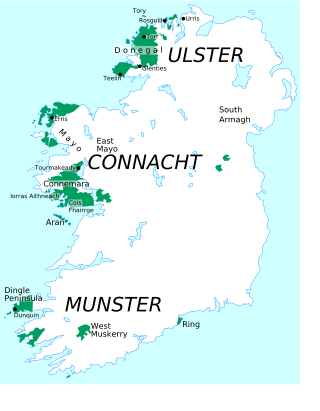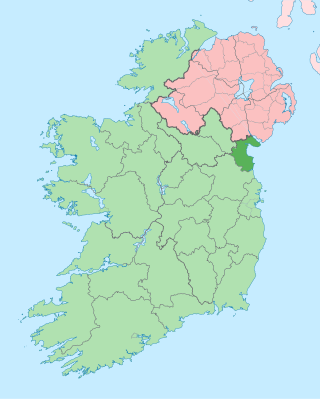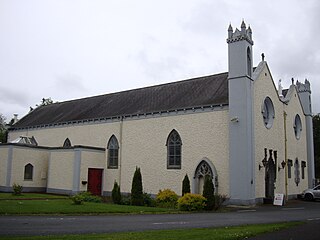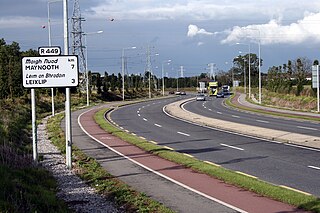
Leinster is one of the four provinces of Ireland, situated in the southeast and east of Ireland.

Portlaoise, or Port Laoise, is the county town of County Laois, Ireland. It is located in the South Midlands in the province of Leinster.

A Gaeltacht is a district of Ireland, either individually or collectively, where the Irish government recognises that the Irish language is the predominant vernacular, or language of the home. The Gaeltacht districts were first officially recognised during the 1920s in the early years of the Irish Free State, following the Gaelic revival, as part of a government policy aimed at restoring the Irish language.

County Louth is a coastal county in the Eastern and Midland Region of Ireland, within the province of Leinster. Louth is bordered by the counties of Meath to the south, Monaghan to the west, Armagh to the north and Down to the north-east, across Carlingford Lough. It is the smallest county in Ireland by land area and the 17th most populous, with just over 139,100 residents as of 2022. The county is named after the village of Louth. Louth County Council is the local authority for the county.

Ballyhaunis is a town in County Mayo, Ireland. It is at the crossroads of the N60 and N83 National secondary roads and on the railway line linking Dublin to Westport and Ballina.

Third-level education in the Republic of Ireland includes all education after second-level, encompassing higher education in universities and colleges and further education on Post Leaving Certificate (PLC) and other courses.

A regional road in the Republic of Ireland is a class of road not forming a major route, but nevertheless forming a link in the national route network. There are over 11,600 kilometres of regional roads. Regional roads are numbered with three-digit route numbers, prefixed by "R". The equivalent road category in Northern Ireland are B roads.

Islam is a minority faith in Wales followed by 2.2 % of its population with about 64,000 adherents recorded as per 2021 Census up from about 46,000 adherents in the 2011 Census. The earliest recorded connections between Wales and the Muslim world dates back to the early 12th Century. There has been a Somali and Yemeni Islamic community in Cardiff since the mid-19th century, founded by seafarers to Cardiff Docks. The first purpose-built mosque was erected in Cardiff in 1947.

Cork is the second largest city in the Republic of Ireland, third largest on the island of Ireland, and largest in the province of Munster. At the 2022 census, it had a population of 224,004.

The Islamic Cultural Centre of Ireland is an Islamic complex, including a mosque, in Clonskeagh, Dublin, Ireland. It is funded by the al-Maktoum Foundation of Dubai and has a Sunni orientation.
The Irish Council of Imams is an umbrella organisation for most Islamic establishments in Ireland. Its formation was announced in a press release on 15 September 2006. It represents 35 imams in Ireland, of both the Sunni and Shia denominations, but excludes Ahmadiyya. The chairman is Imam Hussein Halawa, the deputy chairman is Imam Yahya Al-Hussein, and the general secretary is Belkacem Belfedhal. The Council consists of representatives from Cork, Galway, Limerick, Waterford, Meath, and Dublin mosques.

Islam in Northern Ireland details Islam in Northern Ireland since its creation as a separate country within the United Kingdom on 3 May 1921, under the Government of Ireland Act 1920.

The Mid-West is a strategic planning area within the Southern Region in Ireland. It is a NUTS Level III statistical region of Ireland. It consists of the counties of Clare and Tipperary, and the city and county of Limerick. Limerick City is the economic centre of the region. It spans 10,511 km2, 14.95% of the total area of the state and as of the 2022 census, it had a population of 505,369.
Somali Australians are citizens and residents of Australia who are of Somali ancestry.
The Al-Mustafa Islamic Cultural Centre Ireland, which started its activities as Clonee Mosque, based in the village of Clonee, is the mainstream and leading Islamic Centre in Dublin 15, Ireland. It was established in January 2004 as Clonee Mosque, to act as a place of worship for the Muslim community in Clonee and surrounding areas of Dublin 15.

Umar Al-Qadri is a Sunni Islamic scholar and sheikh based in Ireland who was born to a Pakistani Muslim scholarly family. His father is Sunni Muslim scholar Mehr Ali Qadri, who arrived in the late 1970s in The Hague, Netherlands, to serve as an Imam. Al-Qadri is also the Chair of the Irish Muslim Peace & Integration Council, a national representative Muslim body with a presence in Dublin, Cork, Athlone, Portlaoise and Belfast.

Hinduism is a minority religion in Ireland, followed by 0.7% of the country's population. It is also the second fastest-growing religions by percentage in Ireland. There are also a small number of recognised temples in the country.

Ahmadiyya is a community in Ireland under the spiritual leadership of the caliph in London. The Community was formally registered in the country in 1992, during the era of the Fourth Caliphate. Today there are two Ahmadiyya mosques in the country, one of which is purpose-built, representing up to 500 Ahmadis in the country.
The Cork Islamic Cultural Centre (CICC) is an Irish-registered non-profit organisation established to "invite Muslims back to the teachings of the Quran and Sunnah and to educate Non-Muslims about Islam." It opened in October 2013 in an effort to serve the second largest Muslim community in Ireland. The "mega mosque", as it is often called, was constructed with about €800,000 in donations from Qatar.



















